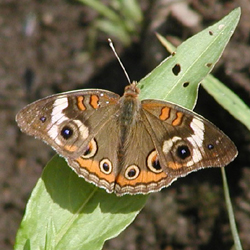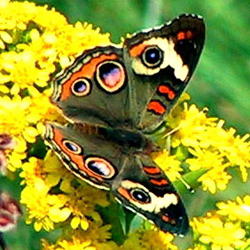Butterfly Atlas
Find a Butterfly
Common Buckeye
Junonia coenia
Named
Hubner, 1822

Identification
Wingspan: 2-2 1/2". Can be instantly recognized by upperwing pattern: three large eyespots, ringed with yellow; broad creamy band crossing forewing and encircling forewing eyespot; and two orange bands on the front edge of the forewing.
Distribution
All of United States and southern Canada, excepting northwesternmost U.S. and adjacent Canadian provinces; south to Mexico. Also, Bermuda, Bahamas, and Cuba. Resident throughout the South only. In New England, variable (scarce to fairly common) in southern parts; usually absent from northern states.
Status in Massachusetts
Scudder (1889) described the Common Buckeye as "exceedingly rare in New England" and then proceeded to detail a lengthy list of Massachusetts towns in which the butterfly had been captured. Farquhar (1934) called it "very rare". We now know that the Common Buckeye is a summer and fall visitor only (it is unable to survive cold winters) and re-populates Massachusetts and other northern states almost every year, emigrating northward from resident populations in the South. Common Buckeyes reach Massachusetts in highly variable numbers. Most years produce a weak flight and Buckeyes are found in very low frequency, usually in coastal locations, from mid to late summer. During flight years, such as 1990 & 1994, the species arrives early (June), spreads across suitable lowland areas statewide, and may establish breeding colonies. Typically found singly or in very low numbers. Maxima (at breeding sites): 80, 1990, Falmouth (Barnstable Co.) and 21, on 4 September 1990, Westford (Middlesex Co.). Also over 100 at once at Westport (Bristol Co.), fall 1945.

Flight Period in Massachusetts
Variable, usually July to September. Extreme dates: 4 June 1995, Middlesex Fells (Middlesex Co.) B. Malcolm; 5 June 1990, Westport (Bristol Co.), B. Cassie and 16 November 1990, Duxbury Beach (Plymouth Co.), fide D. Clapp.
Larval Food Plants
Many documented. In the Northeast, larvae usually feed on "members of the snapdragon family (and) plantain family" (Opler and Krizek, 1984), including Blue Toadflax (Linaria canadensis); False Foxglove and gerardias (Gerardia, species), plantains (Plantago, sp.), and Snapdragon (Antirrhinum). Buckeye larvae have been observed in Massachusetts on Butter and eggs (Linaria vulgaris) and Slender Gerardia (Gerardia tenuifolia).
Adult Food sources
Said by Opler and Krizek (1984) to prefer composites. In Massachusetts, (seldom) seen at flowers of Boneset, Black eyed Susan, Grass leaved Goldenrod, asters (composites), Meadowsweet, and White Clover.

Habitat
Open, dry areas at lower elevations. Partial to dirt "right of way" clearings under powerlines.
Life Cycle
EGG: Dark green; dome shaped, with ten vertical walls. OVIPOSITION: Eggs laid singly on the underside and tip of host plant leaves and buds. LARVA: Blackish, with branching spines, orange and yellow lateral striping; red head. CHRYSALIS: Pale brown with darker markings. OVERWINTERING STAGE: Does not overwinter in New England.
Adults emigrate northward into Massachusetts during summer months. Males take up positions, usually on the bare ground, in suitable habitat to await females. They fly up at every passing flying object, seemingly in defense of their territories. Scott (1986) explains, "Although the male behavior of chasing passing objects looks pugnacious, males are not truly territorial but merely looking for females." Mating occurs from morning to mid afternoon.
Common Buckeyes stage notable fall flights, with many thousands at favored coastal locales, such as Brigantine, NJ. The species is a strong flier, with a distinctive flight pattern of flaps alternated with short glides.
Account Author
Brian Cassie



